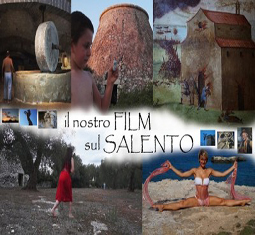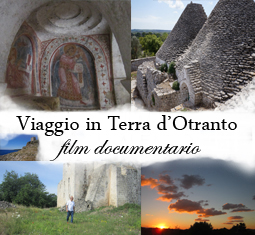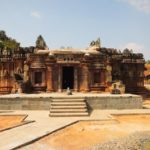
(WITH ENGLISH TEXT)
L’Andhra Pradesh occupa un posto peculiare nella storia dell’architettura rupestre buddista dato che ne è stata interessata un”area che va dalle colline tra i fiumi Krishna e Godavari, fino ai loro delta e ai Ghati orientali. Scavato anche nella roccia arenaria rossa e ocra dalle mille tipologie
in quanto ricca di ferro e di calcio in cristalli e in sabbie, il GRANDE INSEDIAMENTO BUDDHISTA DI GUNTUPALLI è uno splendido esempio in cui sono rappresentate molte delle tipologie dell’architettura Buddhista.
The Andhra Pradesh occupies a unique place in the history of Buddhist since they have been affected seating ranging from the hills between the rivers Krishna and Godavari, up to their delta and the Eastern Ghats. Also dug into the sandstone and red ocher with many tapes as rich in iron and calcium in crystal and sands, the BIG SETTLEMENT OF BUDDHIST GUNTUPALLI is an outstanding example that represented many of the types of Buddhist architecture.
Anche qui, come in molti insediamenti buddhisti del Maharashtra, non c’è un modello architettonico fisso ma variano sia i rupestri che i strutturali. Marcato dalla sua semplicità, l’intero monastero è attribuito alla prima architettura monastica buddista. Alcune sono semplici camere scavate nella roccia che servivano al riparo e quindi erano viharas, altri sono stupa (tumuli celebrativi) e chaityas (templi). Here, as in many settlements Buddhists of Maharashtra, there is an architectural model fixed but vary in the rock that structural. Marked by its simplicity, the entire monastery is attributed to the first Buddhist monastic architecture. Some are simple cave rooms that were used to shelter and then were Viharas, others are Stupas (commemorative burial mounds) and Chaityas (temples).
Essi sono datati tra il 2 secolo aC e il 5th-6th dC. I primi sono stati scavati dal 2 sec a.c. sotto il patrocinio dei Satavahana e sostenuti d. c. dai governanti Ikshvaku, gli stessi che hanno sostenuto i monasteri di Nagarjunakonda. They are dated between the second century BC and the 5th-6th AD. The first were dug under the auspices of and supported Satavahanas, AD Ikshvaku rulers, the same that supported the monasteries of Nagarjunakonda.
Il sito inizia alla base di una valletta orientata sud nord che si esaurisce a nord contro un crinale perpendicolare, su cui sono posti un gruppo di vihara e tutti gli edifici strutturali di mattoni. Dall’altra parte del crinale nord è presente un altro gruppo di viharas. The site begins at the base of a valley oriented north south which is exhausted to the north against a ridge perpendicular, on which are placed a group of vihara and all the buildings structural brick. On the other side of the ridge north there is another group of viharas.
La quantità di edifici di questo sito buddhista ci fa capire quanto fosse importante e numerosa la sua comunità monastica e la sua longevità, rispetto ad altri siti, ci testimonia che questa era una comunità ben radicata sul territorio, che non ha sofferto le crisi religiose e i problemi di sostentamento, che hanno afflitto molti altri siti buddhisti nel corso dei secoli. Un’evidenza strana rispetto agli altri monasteri del Maharashtra è che qui non è stata scavata nessuna immagine del Buddha nel periodo d.c. Ciò potrebbe significare che questo gruppo di monaci apparteneva ad un filone ortodosso del buddhismo, che ha mantenuto intatto nel tempo il suo spirito aniconico. The amount of buildings of this Buddhist site makes us realize how important it was large and his monastic community and its longevity compared to other sites, testifies that this was a community rooted in the territory, which has not suffered from the crisis and religious livelihood issues, which have plagued many other Buddhist sites throughout the ages. Evidence strange compared to other monasteries of Maharashtra is here that has not been excavated no image of the Buddha in the period AD This could mean that this group of Orthodox monks belonged to a strand of Buddhism, which has preserved over time his spirit aniconic.
I monumenti più importanti del sito sono :
1) GRUPPO DI VIHARAS IN GROTTE NATURALI – In queste sale, che paiono essere state grotte naturali, erano ricavate parecchie camere. Ora però è tutto fatiscente, in quanto rimangono riconoscibili solo gli scavi sulla parete di fondo. C’erano 3 livelli di residenze e quella centrale, la più estesa, aveva parecchie camere, le cui pareti laterali sono state distrutte. The most important monuments of the site are: 1) GROUP OF VIHARAS IN NATURAL CAVES – In these place, which appear to have been natural caves, were obtained several rooms. But now everything is crumbling, because they remain recognizable only the excavations on the back wall. There were three levels of residences and the central one, the largest, had several rooms, whose side walls were destroyed.
2) MAHA CHAITYA Databile al secondo secolo a.C. il VRITTA CHAITYA è situato all’ingresso meridionale della collina ed è particolarmente interessante per la sua pianta circolare e il piccolo circumambulatorio che gira intorno al grezzo e piccolo stupa monolitico circolare che sta al centro. Localmente conosciuto dagli induisti come Dharmalingeswara, nonostante la cospicua dimensione della facciata, all’interno è molto piccolo, a differenza dei soliti chaitya dei primi secoli a.C. 2) Maha Chaitya Dating from the second century BC, the Vritta Chaitya It is located at the southern entrance of the hill and is particularly interesting because of its circular shape and the small circumambulatory that revolves around the raw and small circular monolithic stupa that is at the center. Locally it is known by Hindus as Dharmalingeswara, despite the considerable size of the facade, inside is very small, unlike the usual chaitya of the first centuries BC.
All’esterno presenta una doppia facciata. La prima, esterna, è il grande scavo quadrato di 5 x 5 m c che contiene lo scavo ad arco della soglia e in alto la sagoma di un grande arco chaitya, che protegge e copre l’entrata, decorato con travetti ornamentali orizzontali, come si è visto nel famoso tempietto di Lomasrishi in Bihar. Parecchio restaurata, questa parte è caratterizzata da una lavorazione molto grezza, con geometrie formate da piani approssimativi; lavorazioni assai diverse da quelle precise e più curate dei siti del Maharastra. Externally it’s double-sided. The first, external, it is the great excavation square of 5 x 5 mc that contains the digging arc of the threshold and at the top the shape of a large arc chaitya, which protects and covers the entrance, decorated with ornamental horizontal joists, as It is seen in the famous temple of Lomasrishi in Bihar. Several restored, this part is characterized by a very rough machining, with geometries formed by planes approximate values; processes very different from those precise and treated sites of Maharashtra.
Lo scavo, prima di accedere alla sala interna, si allarga, formando un piccolo vestibolo con una seconda facciata costituita da una parete curva in cui è scavata la porta d’ingresso, sormontata da una piccola tettoia, sempre circolare, simile a quelle della Sudama Cave in Bihar e del Chaitya di Kondivite in Maharastra. Le datazioni per Bihar sono 250 a.c. c e 120 a.c. per Kondivite (Dheeja), per cui, valutando le dimensioni e la struttura, questo di Guntupalli si porrebbe tra i due, appunto nella seconda metà del secondo secolo. The excavation, before accessing the interior room, widens, forming a small vestibule with a second side formed by a curved wall on which is carved the front door, topped by a small shed, always circular, like those of Sudama Cave in Bihar and the Chaitya of Kondivite in Maharastra. The dating for Bihar are 250 BC c and 120 BC for Kondivite (Dheeja), for which, considering the size and structure of this Guntupalli would arise between the two, in fact in the second half of the second century BC.
L’interno ha un bellissimo soffitto a cupola segnato da nervature scolpite come una ragnatela, copia della struttura di un ombrello di legno, o dell’abside dei templi circolari strutturali di legno, o al soffitto di una capanna di bambù (Kuta). The interior has a beautiful domed ceiling marked by ribs carved like a spider web, a copy of the structure of a wooden umbrella, or the apse of the temples circular structural wood, or ceiling of a bamboo hut (Kuta).
Esso sovrasta un piccolo stupa monolitico, scavato nella stessa roccia del tempio, privo di decorazioni e del tipo più antico, con alto fusto e piccola cupola. La lavorazione è generalmente molto grezza, infatti dappertutto si vedono i segni, anche profondi, delle scalpellate. It overlooks a small stupa monolithic, carved into the rock of the temple itself, devoid of decorations and the oldest type, with tall trees and small dome. The process is generally very rough, in fact everywhere you see signs, even deeper, the chiseled.
3) GRANDE VIHARA DISTRUTTO Questo grande vano presenta alcune camere scavate, a cui sono state spaccate tutte le pareti, ed altre naturali, per cui, col cedimento del fronte, si fatica a capire quale fosse la sua strutturazione originale. La residenza centrale aveva il soffitto inclinato. 3) BIG VIHARA DESTROYED This large room has some cave rooms, which were smashed all the walls, and other natural, so, with the collapse of the front, it is hard to understand what was its original structure. The residence Central had the sloped ceiling.
4) GRANDE MONASTERO DI 3 VIHARAS DECORATI – Il Grande Monastero, formato dalle 3 residenze artisticamente più significative (n.4) è caratterizzato da diverse tipologie di elementi architettonici apparentemente simili. La facciata è divisa da una porta e da finestre : 4 nel primo vihara e due in quelli successivi. In tutti, sia la porta che due finestre sono sormontate da un arco chaitya ricavato nello spessore della roccia. 4) LARGE MONASTERY 3 viharas DECORATED – The Great Monastery, formed by 3 residences most artistically significant , is characterized by different types of architectural elements appear to be similar. The facade is divided by a door and windows: 4 in the first vihara and two in subsequent . In all, both the door that two windows are surmounted by an arch chaitya formed in the thickness of the rock.
Nelle lunette degli archi sono accennati i raggi di una grata che si irradia a forma di mezzaluna. Semplice, nella sua pulizia geometrica, questo è l’unico elemento decorativo, oltre all’arco, che si ripete in tutto l’insediamento rupestre di Guntupalli. Il basamento è semplice e non ci sono decorazioni. In the lunettes of the arches are mentioned rays of a grate that radiates in a crescent shape. Simple, clean in its geometric, this is the only decorative element, in addition to the bow, which is repeated throughout the rock settlement of Guntupalli. The base is simple and there are no decorations.
L’arco chaitya centrale è più grande e il suo nasi (cuspide) arriva al soffitto del grande scavo della facciata, ed è quindi collegato alla parete superiore della montagna. Ai suoi lati, sia a dx che a sx, è scavato un finto tetto a schiena di elefante, elemento insolito nei vihara del Maharastra. The arch chaitya Central is larger and its nasi (cusp) reaches to the ceiling of the great excavation of the facade, and is then connected to the upper wall of the mountain. On either side, is that right to left, dug a false roof in the back of an elephant, unusual element in the vihara of Maharastra.
Il vestibolo è quadrato, (nel primo vihara) e rettangolare (negli altri due). Il soffitto di questi vestiboli è a volta a botte. The hall is square (in the first vihara) and rectangular (the other two). The ceiling of these vestibules is a barrel vault.
L’ultimo vihara presenta all’interno un’interessante facciatina con archi chaitya sopra la porta e le finestre della cella. In Last vihara is interesting decoration Interior small facade with windows, which arches chaitya of door and windows.
Per facilitare lo scarico dell’acqua piovana che scaturiva all’interno, i pavimenti di alcune celle sono state scavati con piccoli canali che drenano l’acqua all’esterno del vihara. To facilitate the discharge of rainwater that flowed inside, the floors of some cells were dug with small canals that drain water out of the vihara.
5) VIHARA NON DECORATO Molto semplice, purtroppo mancante del vestibolo che è andato distrutto, presenta due celle molto spartane e nessuna decorazione. 5) VIHARA NOT DECORATED Very simple, unfortunately missing the vestibule that was destroyed, it has two cells very basic and no decoration.
6) PICCOLO VIHARA LATERALE. Molto carino questo piccolo vihara ricavato in uno spuntone laterale che si conforma come i classici piccoli vihara eremitici: un vestibolo, una saletta e una camera. due arcosoli sono ricavati sulle pareti laterali dell’ingresso. 6) LITTLE VIHARA SIDE. Very cute this little vihara housed in a spike side that conforms like the classic small vihara hermit: a vestibule, a lounge and a bedroom. two arcosolia are formed on the side walls of the entrance.
Salendo sul crinale ci troviamo di fronte ad una vasta area monumentale che doveva essere una sorta di Agorà (luogo d’incontro e celebrazione) per la comunità dei monaci sparsa nei vari viharas. Qui erano realizzate due grandi sale a pilastri, e sono presenti una sessantina di stupa votivi e un grande chaitya circolare di mattoni. We are going up on the ridge we are faced with a vast monumental area that was to be a kind of Agora (meeting place and celebration) for the community of monks scattered in various viharas. Here they were built two large rooms with pillars, and there are about sixty of votive stupas and a large chaitya circular brick.
7) GRANDE MANDAPA CON PILASTRI – Subito, sul pianoro, sono visibili numerosi ceppi di calcare bianco e verdastro, come quello dei siti di Nagarjunakonda, piantati nel terreno, che testimoniano la presenza di una grande sala per riunioni e preghiere. Secondo Alexander Rea, era probabilmente composta da 24 pilastri di pietra disposti in sei file di quattro ciascuno, che coprivano una superficie di 56 x 34 ft con portici d’ingresso sui lati est ed ovest. Vista la presenza dei pilastri si può presupporre che la sala fosse coperta, ma non ci sono elementi per capire se fosse chiusa. I pilastri rimasti mostrano al centro la classica forma a clessidra buddhista, formata da medaglioni di fior di loto che portano dalla sezione quadrata delle estremità a quella ottagonale (Kattu) del centro. Le decorazioni sono approssimative, arcaiche e rozze, riconducibili a quelle viste a Jagayyapeta. La maggior parte dei pilastri contiene scritte donatorie in caratteri Brahmi, che vanno dal 1°al 5°secolo d.C., firmate da diversi Grhapatis e Grhinis (devoti?) provenienti da diverse parti del paese. Questo fatto testimonia la longevità del sito di Guntupalli. 7) Mandapa WITH LARGE PILLARS – Immediately, on the plateau, are visible many strains of limestone white and green, as one of the sites Nagarjunakonda, planted in the ground, which testify to the presence of a large room for meetings and prayers. According to Alexander Rea, it was probably composed of 24 stone pillars arranged in six rows of four each, covering an area of 56 x 34 ft arcaded entrance on the east and west sides. Given the presence of the pillars can be assumed that the hall was covered, but there are elements to understand if it was closed. The pillars were at the center show the classic hourglass shape Buddhist, consisting of lotus medallions that lead from the square end to the octagonal (Kattu) center. The decorations are approximate, archaic and rough, due to those seen in Jagayyapeta. Most of the pillars contains donatorie written in Brahmi characters, ranging from the 1st to the 5th century AD, signed by several Grhapatis and Grhinis (devotees?) From different parts of the country. This fact testifies to the longevity of the site Guntupalli.
8) GRANDE MANDAPA CIRCOLARE – In fondo al pianoro, verso nord, ci sono le tracce di una grande mandapa circolare, realizzata con blocchi e pilastri di ardesia rosso violacea, di sezione sia quadrata che ottagonale. Gli archeologi hanno ricostruito parte della circonferenza esterna, ma la presenza di blocchi anche all’interno fa presupporre che ci fosse un circoambulatorio, con una serie di altri pilastri interni. Una struttura strana e nuova nell’architettura buddhista da me conosciuta, che ricorda il chaitya rupestre circolare di Junnar Leni, che però è tutto scavato nella montagna. 8) BIG Mandapa CIRCULAR – At the end of the plateau, to the north, there are traces of a large mandapa circular, built with blocks and pillars of red slate violet, of octagonal section that is square. Archaeologists have reconstructed the outer circumference, but the presence of even within blocks is to assume that there was a circoambulatorio, with a number of other internal pillars. A strange structure and new Buddhist architecture known to me, who remembers the chaitya rock circular Junnar Leni, but it’s all dug into the mountain.
9) PICCOLO MONASTERO PIU’ ELEVATO L’impressione di queste 5 celle è che appartenessero ai personaggi più significativi della comunità monastica. Sia perchè dominano la vasta area sacra sottostante, sia perchè uno è decorato e ha una unica grande cella che forse era per il priore. Esternamente tutte presentano brandelli di decorazioni di archi chaitya con finti travetti di legno. Purtroppo l’arenaria di questa parete del monte è molto fragile ed erosa, per cui i manufatti sono molto degradati. 9) LITTLE MONASTERY MORE ‘HIGH -The impression of these cells is that they belonged to the most significant figures of the monastic community. And because it dominates the vast sacred area below, and because one is decorated and has a single large cell that maybe it was for the prior. Externally all have bits of decorations of arches chaitya with fake wooden joists. Unfortunately the sandstone wall of this mountain is very fragile and eroded, so the artifacts are very degraded.
10) GRUPPO DI STUPA (A) E TANK – Situata su una delle terrazze della collina, con più di sessanta stupa presenti, questa area sacra stupisce per la quantità e varietà di stupas votivi eretti in diverse occasioni e tempi. Essi variano in forma, dimensioni e modalità di costruzione, in quanto è stata usata sia la pietra che il mattone. La maggior parte ha dimensioni di 3-4 m di diametro, sono bassi, costruiti fino al tamburo e le loro cupole sono mancanti. Altri sono piccoli, ma sviluppati in verticale con un alto tamburo. Molti sono privi di basamento. 10) GROUP STUPA (A) AND TANK – Located on one of the terraces of the hill, with more than sixty stupa present, this sacred area surprised by the quantity and variety of votive stupas erected on several occasions and times. They vary in shape, size and manner of construction, in what has been used as both the stone that the brick. Most has dimensions of 3-4 m in diameter, are low, built up to the drum and their domes are missing. Others are small, but developed vertically with a high drum. Many are devoid of stand.
Lo STUPA più grande è di pietra calcarea bianca e verde e non di mattoni, ed è databile al 2°secolo aC. Scavato da Alexander Rea, grande archeologo protagonista della ricerca in India, vi aveva trovato parecchio materiale interessante : l’albero ad ombrello ( chattra) che una volta incoronava lo stupa, uno scrigno di pietra reliquiaria contenente un piccolo recipiente di rame, un grande cristallo bianco, una perla esagonale, una ciotola d’oro con due perle minuscole d’oro e una figura di Buddha di pietra calcarea rozzamente scolpita. Questo stupa ha subito notevoli danni sulla cupola per via dei tombaroli. Le misure sono 4.88m di diametro x 2.62m d’altezza, ed è stato eretto su un basamento circolare. The STUPA larger white limestone and green and brick, and is dated to the 2nd century BC. Excavated by Alexander Rea, great archaeologist leading the research in India, he had found a lot of interesting material: tree umbrella (chattra) that once crowned the stupa, a treasure trove of stone reliquary containing a small copper pot, a large crystal White, a pearl hexagon, a golden bowl with two tiny gold beads and a figure of Buddha carved limestone crudely. This stupa has undergone significant damage on the dome because of grave robbers. Measurements are 4.88m diameter x 2.62m height, and it was erected on a circular base.
Scendendo lungo la scarpata verso est, a sinistra, si trova, scavata direttamente nella roccia sedimentaria, una grande tank (vasca) per le abluzioni che non presenta rivestimenti di pietra e che non saprei a che periodo assegnare. Sempre sulla roccia pavimentale prossima alla vasca è invece accennato lo scavo di un manufatto ortogonale, di cui non rimane nulla e su cui sono incise delle scritte. Going down the slope to the east, on the left, it is, carved directly into sedimentary rock, a large tank (tank) for ablution that no stone finishes and that I can not be assigned to that period. Always on the rock pavement next to the tub it is instead mentioned the excavation of an artifact orthogonal, of which nothing remains and on which are engraved lettering.
13) GRUPPO DI VIHARA DEL VERSANTE NORD A ridosso della grande foresta che si estende a nord ci sono 4 -5 vihara molto malridotti di cui due probabilmente erano ricavati in grotte naturali. Vi si accede da due sentieri ricavati in posizioni diverse sui pianori degli stupa. Il meglio conservato presenta tracce delle pareti interne che dovevano dividere due celle. 13) GROUP OF THE NORTH SIDE OF VIHARA Close to the great forest that extends to the north there are 4 -5 vihara in a bad state, two of which were probably set in natural caves. It is accessed by two paths obtained in different positions on the plains of the stupa. The best preserved with traces of interior walls that had divided the two cells.
14) GROTTA NATURALE SUL VERSANTE EST – E’ una piccola grotta ora dedicata al culto induista, ma probabilmente una volta abitata da eremiti buddhisti. Purtroppo la cementificazione del pavimento impedisce di capire se ci fossero tracce di giacigli scavati, come è il caso delle grotte naturali usate dagli eremiti Jain in Tamil Nadu. 14) NATURAL CAVE ON EAST SIDE – It ‘a small cave now dedicated to Hindu worship, but probably once inhabited by hermits Buddhists. Unfortunately, the concreting of the floor prevents understand if there were traces of bedding excavated, as in the case of natural caves used by hermits Jain in Tamil Nadu.
Un’osservazione finale doverosa è che, nella maggior parte dei siti Buddhisti ristrutturati dell’India, la pavimentazione di cemento con terrazzi e sentieri, realizzata per rendere agibile il sito al pubblico, ha irrimediabilmente compromesso la conformazione originaria dei siti e l’ulteriore ricerca di materiale archeologico interrato. A final observation is that duty, in most restructured Buddhist sites of India , the concrete floor with terraces and paths made on clearing the site to the public, has irremediably compromised the original conformation of the sites and further research archaeological material underground.
Dando un ultimo sguardo a questo splendido sito Buddhista di Guntupalli, viene a me spontaneo salutare l’immensa bellissima foresta che sta tutto intorno! Giving a last look at this beautiful site of Buddhist Guntupalli, it comes to me spontaneously greet the immense beautiful forest that is all around!
di Gianluigi Vezoli
© Questo sito web non ha scopo di lucro, non userà mai banner pubblicitari, si basa solo sul mio impegno personale e su alcuni reportage che mi donano gli amici, tutti i costi vivi sono a mio carico (spostamenti fra le città del territorio salentino e italiano, spese di gestione del sito e del dominio). Se lo avete apprezzato e ritenete di potermi dare una mano a produrre sempre nuovi reportage, mi farà piacere se acquisterete i miei romanzi (trovate i titoli a questa pagina). Tutto ciò che compare sul sito, soprattutto le immagini, non può essere usato in altri contesti che non abbiano altro scopo se non quello gratuito di diffusione di storia, arte e cultura. Come dice la Legge Franceschini, le immagini dei Beni Culturali possono essere divulgate, purché il contenitore non abbia fini commerciali. I diritti dei beni ecclesiastici sono delle varie parrocchie, e le foto presenti in questo sito sono sempre state scattate dopo permesso verbale, e in generale sono tutte marchiate col logo di questo sito unicamente per impedire che esse finiscano scaricate (come da me spesso scoperto) e utilizzate su altri siti o riviste a carattere commerciale. Per quanto riguarda le foto scattate in campagne e masserie abbandonate, se qualche proprietario ne riscontra qualcuna che ritiene di voler cancellare da questo blog (laddove non c’erano cartelli o muri che distinguessero terreno pubblico da quello privato, non ce ne siamo accorti) è pregato (come chiunque altro voglia segnalare rettifiche) di contattarci alla mail info@salentoacolory.it
























































Leave a reply